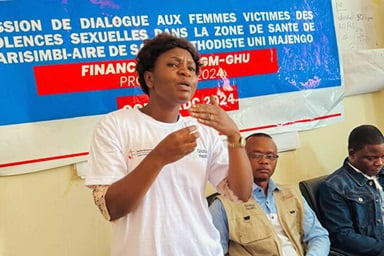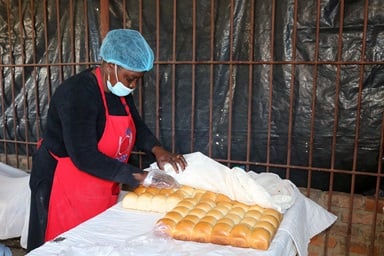Key points:
- The president of The United Methodist Church’s finance agency urged leaders to face the reality of dramatically reduced resources.
- Bishop David Graves was addressing the finance agency’s board as it struggled to meet funding requests in the aftermath of a denominational splintering.
- The board ultimately approved denominational spending for the year ahead. But it needed to adjust its contingency-fund guidelines to respond to one request.
- Graves expressed hope that The United Methodist Church can move beyond relying mainly on the offering plate for support and rebuild for a faithful future.
The United Methodist Church’s financial leaders are sounding the alarm that the denomination cannot continue funding ministry the way it has before.
“The church’s financial house is on fire,” said Bishop David Graves, General Council on Finance and Administration board president. “My intent is not to create fear but to address the reality with honesty and urgency.”
Graves was addressing the board Nov. 14 during its last meeting of 2025 as members struggled to address funding requests for the year ahead.
The denomination is facing an increasingly precarious U.S. economy while still dealing with the aftermath of a splintering that saw a quarter of its U.S. churches leave. While the denomination has more than 11 million members across four continents, U.S. congregations still support the bulk of denominational finances.
“When a house is on fire, the first thing you do is focus on what matters most. For us, that is people, mission and ministry,” Graves said to a chorus of board members saying “Amen.”
“That means every church and conference doing its part through apportionment giving — not because of obligation alone, but because ministry depends on it.”

Apportionments are shares of church giving that sustain United Methodist ministry beyond the work of individual congregations. Denomination-wide ministries receive apportionments from conferences, regional bodies that in turn receive apportionments from the local churches within their borders.
However, Graves also acknowledged that many local churches as well as their conferences are having a tough time meeting their own financial needs.
As of the end of October, U.S. conferences had given about 51.8% of the year’s requested apportionments — or about $45 million so far. Conferences in Africa, Europe and the Philippines overall have paid about 40.7% of requested apportionments — or about $623,400 so far.
In other actions
The General Council on Finance and Administration took other actions at its Nov. 13-14 meeting in Nashville.
The board approved about $98 million in spending plans by general agencies, including GCFA, and other denomination-wide ministries in 2026. The GCFA board’s approval is the final step after each spending plan has received the approval of that ministry’s board as well as a review by the Connectional Table and the board’s own General Agency and Episcopal Matters Committee.
The board also adopted a $19.5 million spending plan for the Episcopal Fund, which supports the work of bishops. That spending plan includes no salary increases and no changes to existing office and housing allowances for the denomination’s 53 active bishops.
In addition, the board supported the recommendation of its Committee on Personnel Policies for a 2.5% increase in the salary scale for agency employees at the 10 agencies supported by apportionments. This does not mean everybody gets a pay hike, but it does adjust the minimum and maximum employee pay within the agencies’ salary structure.
The finance agency offers an overview of its final in-person meeting of the year.
Read press release
While both collection rates are higher than at the same time last year, the total receipts are about $14.8 million less overall. That’s because the denomination’s General Conference, after church disaffiliations, cut the 2025-2028 denominational budget by about 40%.
At this point, the General Council on Finance and Administration is projecting an 83.6% apportionment collection rate for the year. A survey of U.S. conference treasurers in August found they expected a slightly higher collection rate of 84.5%. Either way, that collection rate is about the same as what the denomination saw during the worst of the Great Recession in 2009-2010 — and represents a significantly lower amount of dollars seen then. Basically, even as the denomination asks for less, the portion collected remains historically low.
That drop has huge implications for the ability of the denomination to fund ministry going forward, including work mandated by General Conference, the denomination’s top lawmaking assembly.
During its meeting, the GCFA board struggled with a contingency-fund request from the Standing Committee on Regional Conference Matters Outside the USA. The standing committee — the one denominational body with a majority of members from Africa, Europe and the Philippines — is a permanent committee of General Conference. In the next two years, the international and multilingual group plans to hold two in-person meetings — alongside other United Methodist groups — to finalize its recommendations on what in the Book of Discipline, the denomination’s policy book, applies denomination-wide and what can be modified by the newly ratified regional conferences.
The whole of General Conference has repeatedly authorized this work, outlined in the Discipline’s Paragraph 101. The hope is that once completed with the 2028 General Conference’s approval, the new General Book of Discipline will lead to a shorter, far less expensive and less U.S.-centric General Conference going forward.
To cover travel and translation costs for its two in-person meetings, the standing committee requested $625,000 from the General Administration Contingency Fund.
However, the GCFA board approved funding a little more than half that request — $316,611 — on the recommendation of its General Agency and Episcopal Matters Committee.
“GCFA will work with the Standing Committee and find either alternative sources of revenue or a way to reduce expenses,” said the Rev. Sheila B. Ahler, a longtime accountant and chair of the board’s General Agency and Episcopal Matters Committee.
Even with that reduced amount, the General Agency and Episcopal Matters Committee worried about depleting the contingency fund. The fund, supported by apportionments, is there to meet unforeseen or emergency administrative needs between General Conference sessions. Earlier this year, the finance agency board approved a $1.5 million contingency-fund grant to update the nearly 40-year-old software system used to track legislation at General Conference.
Taken with the already granted contingency fund requests, even the reduced amount approved for the standing committee puts the contingency fund below the $2.2 million minimum long recommended in the GCFA board’s guidelines.
With that in mind, the board voted to decrease its recommended minimum to $1.1 million.
As the denomination adjusts financial constraints, Graves also noted that many in the denomination are already finding ways to save money through technology and by looking for alternatives to apportionments to support ministry.
During the meeting, the board heard a report from John Pearce, a board member who heads the Reserve Fund Task Force. Pearce, who has long served a variety of financial leadership roles in the Tennessee-Western Kentucky Conference, said he is looking at ways agencies “can responsibly leverage their reserves and find better ways to support ministry over the long term.”
He noted that the eight or nine agencies he examined so far had a total of $860 million invested in reserves as of 2024. Last year, he said, those agency investments earned about 6.6% in the stock market — well below the 24-25% returns seen last year on the Standard and Poor’s 500 stock market index.
Subscribe to our
e-newsletter
“We’re not chasing the S&P, and I get that,” Pearce said. “But we could be doing much better.”
He is working with the institutional investment arm of Wespath to help agencies consider ways to improve returns while remaining in line with the denomination’s Social Principles.
Post-disaffiliation, the denomination is rethinking ministry in a variety of ways. A number of conferences also are seeing a boom in church planting often led by committed lay people who wanted to remain in the United Methodist fold even as their former congregations left.
“The fire is real,” Graves said. “And so is our hope. And together, we can protect what matters and rebuild for a faithful future where people experience the love of Jesus, God’s amazing grace and the presence of the Holy Spirit.”
During the board’s opening worship, John Esquivel offered a similar message. The retired lawyer from the Texas Conference admitted that he likes to fiddle with Lego bricks when thinking through a problem. He looked it up on Google and learned that with three identically sized Lego bricks, a person can make up to 1,560 different configurations. There's a lesson for the church in how much can be done with three simple pieces, Esquivel said.
“When we can’t see a way forward, might God be calling us to see new combinations — new ways to use what he has already entrusted,” he said.
“My experience is that God rarely adds new pieces right away. Instead, I believe, he arranges what is already there — our experiences, our relationships, even our disappointments — to build something new in God’s hands.”
Hahn is assistant news editor for UM News. Contact her at (615) 742-5470 or [email protected]. To read more United Methodist news, subscribe to the free UM News Digest.




